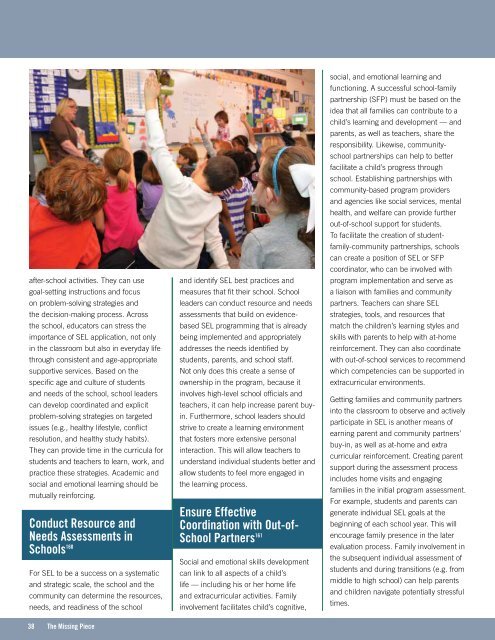CASEL-Report-low-res-FINAL
CASEL-Report-low-res-FINAL
CASEL-Report-low-res-FINAL
Create successful ePaper yourself
Turn your PDF publications into a flip-book with our unique Google optimized e-Paper software.
after-school activities. They can use<br />
goal-setting instructions and focus<br />
on problem-solving strategies and<br />
the decision-making process. Across<br />
the school, educators can st<strong>res</strong>s the<br />
importance of SEL application, not only<br />
in the classroom but also in everyday life<br />
through consistent and age-appropriate<br />
supportive services. Based on the<br />
specific age and culture of students<br />
and needs of the school, school leaders<br />
can develop coordinated and explicit<br />
problem-solving strategies on targeted<br />
issues (e.g., healthy lifestyle, conflict<br />
<strong>res</strong>olution, and healthy study habits).<br />
They can provide time in the curricula for<br />
students and teachers to learn, work, and<br />
practice these strategies. Academic and<br />
social and emotional learning should be<br />
mutually reinforcing.<br />
Conduct Resource and<br />
Needs Assessments in<br />
Schools 160<br />
For SEL to be a success on a systematic<br />
and strategic scale, the school and the<br />
community can determine the <strong>res</strong>ources,<br />
needs, and readiness of the school<br />
38 the Missing Piece<br />
and identify SEL best practices and<br />
measu<strong>res</strong> that fit their school. School<br />
leaders can conduct <strong>res</strong>ource and needs<br />
assessments that build on evidencebased<br />
SEL programming that is already<br />
being implemented and appropriately<br />
add<strong>res</strong>ses the needs identified by<br />
students, parents, and school staff.<br />
Not only does this create a sense of<br />
ownership in the program, because it<br />
involves high-level school officials and<br />
teachers, it can help increase parent buyin.<br />
Furthermore, school leaders should<br />
strive to create a learning environment<br />
that fosters more extensive personal<br />
interaction. This will al<strong>low</strong> teachers to<br />
understand individual students better and<br />
al<strong>low</strong> students to feel more engaged in<br />
the learning process.<br />
Ensure Effective<br />
Coordination with out-of-<br />
School Partners 161<br />
Social and emotional skills development<br />
can link to all aspects of a child’s<br />
life — including his or her home life<br />
and extracurricular activities. Family<br />
involvement facilitates child’s cognitive,<br />
social, and emotional learning and<br />
functioning. A successful school-family<br />
partnership (SFP) must be based on the<br />
idea that all families can contribute to a<br />
child’s learning and development — and<br />
parents, as well as teachers, share the<br />
<strong>res</strong>ponsibility. Likewise, communityschool<br />
partnerships can help to better<br />
facilitate a child’s prog<strong>res</strong>s through<br />
school. Establishing partnerships with<br />
community-based program providers<br />
and agencies like social services, mental<br />
health, and welfare can provide further<br />
out-of-school support for students.<br />
To facilitate the creation of studentfamily-community<br />
partnerships, schools<br />
can create a position of SEL or SFP<br />
coordinator, who can be involved with<br />
program implementation and serve as<br />
a liaison with families and community<br />
partners. Teachers can share SEL<br />
strategies, tools, and <strong>res</strong>ources that<br />
match the children’s learning styles and<br />
skills with parents to help with at-home<br />
reinforcement. They can also coordinate<br />
with out-of-school services to recommend<br />
which competencies can be supported in<br />
extracurricular environments.<br />
Getting families and community partners<br />
into the classroom to observe and actively<br />
participate in SEL is another means of<br />
earning parent and community partners’<br />
buy-in, as well as at-home and extra<br />
curricular reinforcement. Creating parent<br />
support during the assessment process<br />
includes home visits and engaging<br />
families in the initial program assessment.<br />
For example, students and parents can<br />
generate individual SEL goals at the<br />
beginning of each school year. This will<br />
encourage family p<strong>res</strong>ence in the later<br />
evaluation process. Family involvement in<br />
the subsequent individual assessment of<br />
students and during transitions (e.g. from<br />
middle to high school) can help parents<br />
and children navigate potentially st<strong>res</strong>sful<br />
times.


